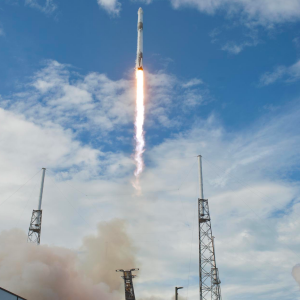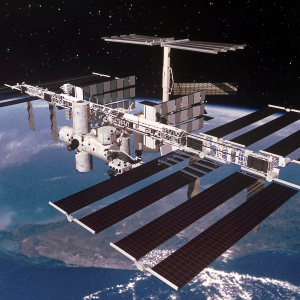
It costs a lot of money to send something to space. One estimate put the current cost of sending a bottle of water to the International Space Station (ISS) between $9,000 and $43,200. Accordingly, it’s important to know every single item, and its exact location on the ISS.
 At the microscopic level, we just made a big leap forward in that department. A paper recently published in Microbiome characterizes the microbiome of the ISS, giving us a picture of the only extraterrestrial life we can confirm…aside from the astronauts themselves, of course.
At the microscopic level, we just made a big leap forward in that department. A paper recently published in Microbiome characterizes the microbiome of the ISS, giving us a picture of the only extraterrestrial life we can confirm…aside from the astronauts themselves, of course.
These efforts will help prepare humans to go deeper into space than ever.
Why does the microbiome matter?
The microbiome includes all the bacteria, viruses, fungi and other single-celled life forms that make up the world around us, and in a way, the world that is us. Every single person has a diverse microbiome, full of trillions of microorganisms. It’s an incredibly important piece of human health.
In fact, I believe so strongly in the importance of the microbiome that I dedicated my entire 2019 Biotech 201 series to the secrets of the human microbiome. You can watch those talks for yourself if you want more information (or anytime you’re craving a dose of science).
Evidence continues to grow that the microbiome plays an enormous role in human health, perhaps bigger than we’ve imagined. Just this year, researchers published a paper in Science Advances exploring the potential impact of the gut microbiome on schizophrenia symptoms. We even detailed a hypothesis that gum disease might be linked to Alzheimer’s in an earlier Shareable Science.
The microbiome is almost as expansive as space itself and understanding it could give invaluable information about our overall health.
How might the microbiome contribute to space travel?
Still, you might find yourself wondering why not just study the microbiome right here on Earth. What does it have to do with space travel?
 If we truly intend to send people to space for long-range travel, we need to prepare thoroughly for different health outcomes. The trip to Mars is roughly 40-million miles (both planets are constantly moving orbit, so there’s no set distance between them). Assuming you’re not going to fly there only to turn around and fly back, you would need to plan for astronauts to be in space for at least a year. The important difference between this kind of space travel and, say, a year on the ISS is that you could not quickly respond to a health emergency. In fact, we developed an interactive learning experience based around this very idea, called Touching Triton. Try it out! You’ll find that filling the suitcase for deep space travel creates quite a challenge.
If we truly intend to send people to space for long-range travel, we need to prepare thoroughly for different health outcomes. The trip to Mars is roughly 40-million miles (both planets are constantly moving orbit, so there’s no set distance between them). Assuming you’re not going to fly there only to turn around and fly back, you would need to plan for astronauts to be in space for at least a year. The important difference between this kind of space travel and, say, a year on the ISS is that you could not quickly respond to a health emergency. In fact, we developed an interactive learning experience based around this very idea, called Touching Triton. Try it out! You’ll find that filling the suitcase for deep space travel creates quite a challenge.
Remember what we said about how much it costs to send a bottle of water to the ISS. You can’t just pack the medicine cabinet, and you can’t send a bunch of extra crew in case someone needs a sick day or medical leave.
The more we understand about the microbiome and how it reacts to extended time in space, the more accurately we can project the health needs of astronauts and prepare for prolonged space travel.
What was found?
If astronauts aren’t technically alone in space, it makes sense to know what other life they’re hanging out with. So what did researchers find when they indexed the microbiome of the ISS?
Technology Networks summed up the findings:
The researchers found that microbes on the ISS were mostly human-associated. The most prominent bacteria were Staphylococcus (26% of total isolates), Pantoea (23%) and Bacillus (11%). They included organisms that are considered opportunistic pathogens on Earth, such as Staphylococcus aureus (10% of total isolates identified), which is commonly found on the skin and in the nasal passage, and Enterobacter, which is associated with the human gastrointestinal tract. On Earth, they are predominant in gyms, offices, and hospitals, which suggests that the ISS is similar to other built environments where the microbiome is shaped by human occupation.
While it stands to reason the ISS would resemble anywhere else humans live and work, it’s worth noting that these tiny organisms face challenges in the ISS, just like humans. The paper itself notes:
The ISS is a hermetically sealed closed system, subjected to microgravity, radiation, elevated carbon dioxide, and the recirculation of air through HEPA filters and is considered an “extreme environment”.
Of course, an “extreme environment could kill off some of the typical microbes you find on Earth, but those same conditions could also promote resilient microbes. Again, from the paper:
Microbes are known to survive and even thrive in extreme environments, and the microbes that are present on the ISS may have existed since the inception of the ISS while others may be introduced each time new astronauts or payloads arrive.
The final frontier
There’s still a lot to do in order to understand the microbiome—on Earth or otherwise.
However, improving our grasp of its function could mean dramatic breakthroughs for human health. The microbiome could be contributing to everything from our digestive process to Alzheimer’s to schizophrenia. Unlocking even some of its secrets could give us entirely new vectors to attack disease—or a better way to maintain health.
It only makes sense we’d take that research to space. Astronauts already have to pass a long-duration astronaut physical, to ensure they’re physically fit for the job. However, the more we can incorporate into that understanding, the better we can prepare for even deeper space travel.
To schedule a media interview with Dr. Neil Lamb or to invite him to speak at an event or conference, please contact Margetta Thomas by email at mthomas@hudsonalpha.org or by phone: Office (256) 327-0425 | Cell (256) 937-8210
Get the Latest Sharable Science Delivered Straight to Your Inbox!
[gravityform id=19 title=false description=false ajax=true][wprpw_display_layout id=8]


